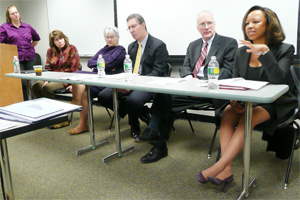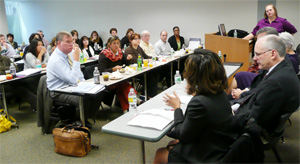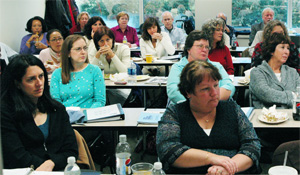TIPS FOR SURVIVING THE GREAT RECESSION — FROM THE CFOS AT THE FRONT LINESBe strategic and focus exclusively on your core mission. If you have to lay off staff, do it all at once and only once. Be more creative. Undertake more marketing to build new relationships with key constituents. Consider merging with another nonprofit. Generate long-term financial forecasts. WHAT HAS BEEN THE IMPACT OF THE RECESSION? The economic downturn has been simply “horrible,” said Miriam Schaefer of the Chemical Heritage Foundation. Or, as Pat Meller of The Philadelphia Foundation said, “It’s scary for the nonprofit – really, really scary.”
 Regine Metellus When the Urban League of Philadelphia, like many nonprofits, experienced reduced donations and 30-40% increases in demands for services, the League had to re-engineer its program to provide additional services without adding additional staff, said Regine Metellus. Yet the League, seeing a cycle of deficits that followed several years of surpluses, took an almost Biblical view of conditions that helped them conceptualize and survive the downturn. “Because we were already very lean to begin with and didn’t want to cut into bone, we had to be more creative and take advantage of in-kind contributions and people wanting to volunteer their time,” Metellus said. “The recession has made us be more creative with what we have.”
 Jeff Perkins The Franklin Institute also had its ups and downs, having just experienced a banner year with its King Tut exhibit breaking all attendance and revenue records, resulting in a growth in staff. Then the spike in gas prices in early 2008 severely curtailed school bus trips, which impacted the Franklin Institute’s revenue, said Jeff Perkins. HOW ARE NONPROFITS COPING WITH THE RECESSION? Staff cutbacks were a common theme expressed by the panelists. At St. Joseph’s University, there have been no layoffs, but instead a voluntary reduction in force, said Lou Mayer. The school has not implemented a hiring freeze but rather a hiring “frost,” and using a lot of employment temps.
 Miriam Schaefer Several panelists agreed that if personnel need to be cut, the best approach is to do it all at once because the experience is so unsettling and demoralizing. “Our board of directors decided to cut staff once and not get into a death spiral,” said Schaefer, describing a 15% reduction in force. Another common theme was the need to keep relationships strong. “Our goal this past year has been to keep donors near, dear and clear,” said Meller. “The key thing is relationships. Building new relationships at this time is a challenge, so there’s more of a need for marketing,” said Metellus. The Chemical Heritage Foundation hired a vice president for development. “If we’re ever going to get out of this, we’ll need someone to lead us out,” said Schaefer. The Franklin Institute, as with many nonprofits, is identifying and focusing on core programs more closely. At St. Joseph’s University, “We’re taking a more business-like approach to our whole enterprise,” said Mayer, with profitability analyses and business reviews determining which programs are making money and which ones are losing.
|
 A panel of distinguished chief financial officers
 Staff of Your Part-Time Controller receive Meanwhile, many organizations are cutting discretionary spending for travel and conferences, and expanding Web-based activities to serve more people less expensively. Nonprofits are accepting deficit budgets, considering merging or consolidating services with other organizations, and creating contingency plans. “For the foreseeable future, nothing is going to be as it was,” said Mayer. IS THERE A BRIGHT SIDE? The economic downturn has caused many nonprofits to “activate their creativity,” as Schaefer said, and to not take anything for granted. “Even before the current downturn, nonprofit organizations were under pressure to be more accountable. When the bottom fell out, it forced a lot of them to be smarter, more creative, and to step up their game,” said Metellus. There’s now much more interest among boards of directors in taking a longer-term view, with a greater focus on cash management and three-year cash flow forecasts. Endowments are being shifted into cash positions, and boards are planning best-, middle- and worst-case scenarios based upon potential reductions.
 Lou Mayer “It was good that we went through these scenarios, because they made people aware of how they would deploy a plan if the situation got worse,” said Mayer. “It was not an easy exercise, and we only had to do a 3% scenario, but it’s still not over. Our whole approach to financial forecasting and modeling has been elevated to a higher level and will be standard operating procedures from here on forward.” The recession helped The Franklin Institute get back to what Perkins called “a right size. But there’s still uncertainty as to what we’ll look like as we come out of this on the other end.” DO THE CFOS HAVE ANY ADVICE? “Don’t go back to ‘normal’ too quickly,” suggests the Urban League’s Metellus. “Seize the opportunity to identify what you didn’t really need.” St. Joseph’s Mayer sees opportunities for those organizations who are making lemonade out of today’s lemons. “The nonprofits who are diligently working today to plan for their futures will be the ones who come out ahead.”
 Pat Meller But perhaps the best advice came from The Philadelphia Foundation’s Meller. “Have a sense of humor,” she said. “you’ll need it. Make sure you understand the mission and values of your organization and base your decisions on them. And hold on – it’s going to be a wild ride.” |
Tips to Weather the Recession







